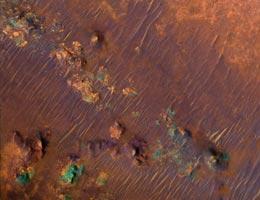 Nili Fossae is a hotspot for martian methane, says Michael Mumma (below).JPL-Caltech/Univ. Arizona/NASA
Nili Fossae is a hotspot for martian methane, says Michael Mumma (below).JPL-Caltech/Univ. Arizona/NASAPosted on 10/21/2008 2:54:46 PM PDT by neverdem
Finding could influence choice of landing site for Mars Science Laboratory.
Ithaca, New York
More than four years after researchers first said they had found methane gas on Mars, a scientist claims that he has "nailed" the controversial detection and identified key sources of the gas.
 Nili Fossae is a hotspot for martian methane, says Michael Mumma (below).JPL-Caltech/Univ. Arizona/NASA
Nili Fossae is a hotspot for martian methane, says Michael Mumma (below).JPL-Caltech/Univ. Arizona/NASAOn Earth, methane is mostly biological in origin; on Mars, it could signal microbes living deep underground. The latest work suggests that martian methane is concentrated in both space and time - at a handful of hotspots hundreds of kilometres across, plumes of methane bloom and dissipate in less than a year.
News of the detection is rippling through the Mars community just months before a destination is picked for the Mars Science Laboratory (MSL), the US$2-billionrover that is due to launch in 2009. It will carry an instrument that could both detect trace amounts of methane and help discern whether it is of biological or geological origin. One of the proposed methane plumes blankets one of the seven possible landing sites: Nili Fossae, which was given a middling ranking by the science community after a September evaluation that did not consider the emerging methane results.
"Now we've got these little signposts saying: 'Look, here I am. Come here!'" says Michael Mumma, a planetary scientist at NASA's Goddard Space Flight Center in Greenbelt, Maryland. He presented his team's work on 11 October at a meeting of the American Astronomical Society in Ithaca, New York.
 Michael Mumma, of NASA's Goddard Space Flight Center in Greenbelt, Maryland.NASA
Michael Mumma, of NASA's Goddard Space Flight Center in Greenbelt, Maryland.NASAMumma has been arguing for methane on Mars since 2003, when other startling findings began to emerge. One group, using the Canada-France-Hawaii Telescope on Mauna Kea, Hawaii, found global trace methane levels of 10 parts per billion, but could see no more detail than that. A second group, using thousands of spectra taken by the European Space Agency's Mars Express orbiter, found similar global levels, with hints of regional variability in concentration (V. Formisano et al. Science 306, 1758-1761; 2004). But some of that paper's impact was diluted when the lead investigator, Vittorio Formisano of the Institute of Physics and Interplanetary Space in Rome, made separate claims of ammonia and formaldehyde that have not been confirmed.
Mumma, a spectroscopy expert, obtained data from telescopes in Hawaii and Chile that supported the notion of methane hotspots.
Now he says he knows for sure and is ready to publish. Having obtained four more years of data, Mumma has confirmed the presence of methane by matching four lines in his infrared spectra of the planet's atmosphere to the characteristic signature of methane - a more definite determination than previous analyses - and found more evidence that the methane is localized in discrete hotspots, which peak at levels of 60 parts per billion. "His numbers have changed a lot over time. But Mike has made a pretty compelling case," says Steven Squyres, a planetary scientist at Cornell University in Ithaca, and principal investigator for the Mars rovers Spirit and Opportunity.
“Now we've got these little signposts saying: 'Look, here I am. Come here!'”
More important than the peak concentrations, Mumma says, are the short lifetimes of the plumes. Previously, methane was thought to be destroyed in the atmosphere by sunlight - a slow process that allows the gas to mix in the atmosphere and persist for about 300 years. A global level of 10 parts per billion and a lifetime of hundreds of years means that a few hundred tonnes of methane are entering the atmosphere each year: the work of a few thousand cows. But plumes of 60 parts per billion that live for less than a year imply a methane-production rate several orders of magnitude higher. "This is a big deal," says Sushil Atreya of the University of Michigan in Ann Arbor, a co-author of the 2004 Mars Express paper.
Whether the methane plumes are biological or geological in origin is impossible to know at the moment, says Atreya. For example, microbes could be living in deep groundwater below a permafrost zone, and their waste methane could percolate up and leak out. The methane could also come from chemical reactions in which buried volcanic rocks rich in the mineral olivine interact with water. A third possibility is that the methane is escaping from buried clathrates, deposits of methane ice formed long ago by one of the other two mechanisms.
But NASA's next Mars rover will be able to analyse, at levels of parts per trillion, the fractional concentrations of the carbon isotopes in each methane molecule. Life on Earth prefers to process lighter carbon-12 atoms. And so, on Mars, methane freighted with carbon-12 could be a sign of a biological origin.
John Grotzinger, a geologist at the California Institute of Technology in Pasadena and project scientist for the MSL, says the methane detection could be important in deciding the MSL's destination. "We're going to take this very seriously," he says. "We all need to sit back and evaluate the data and find out if Nili Fossae is the only place where this occurs." The methane results could be considered at a meeting early next month, when the seven sites are evaluated from an engineering and safety standpoint.
A reshuffling of the sites' rankings could be in order, Grotzinger adds, but he wants some hard data to consider. "Talks don't count. The paper needs to be published," he says.
A paper describing Mumma's work is under review at Science.
If there is methane, there must be cows as well!
The temperature on Mars at night often reaches -100 degrees F. Wonder if Algore can explain how a planet with an atmosphere consisting mostly of CO2 with a high percentage of Methane is so cold?
Martian farts ... must be all that splenda and government cheese they’ve been eating.
Plumes of Methane? There are cows on Mars? Or did Gore get there by shuttle?
Hilarious!
 |
||
| · join · view topics · view or post blog · bookmark · post new topic · | ||
Thanks for the ping. I gather this is going to be a humorous thread.
I’m pretty sure someone will mention Uranus at some point.

Where there is gas there is oil.
Drill Mars! :-)
Now...were there oil discovered on Mars!...
Ping...
Illudium Q-36 Explosive Space Modulator
“Where’s the big kaboom? There’s supposed to be an Earth-shattering kaboom!”


"Get your ass to Mars!"

"I can't breath. That must have been a nasty bit of gas you passed." ;)


oh....excuse me
Disclaimer: Opinions posted on Free Republic are those of the individual posters and do not necessarily represent the opinion of Free Republic or its management. All materials posted herein are protected by copyright law and the exemption for fair use of copyrighted works.